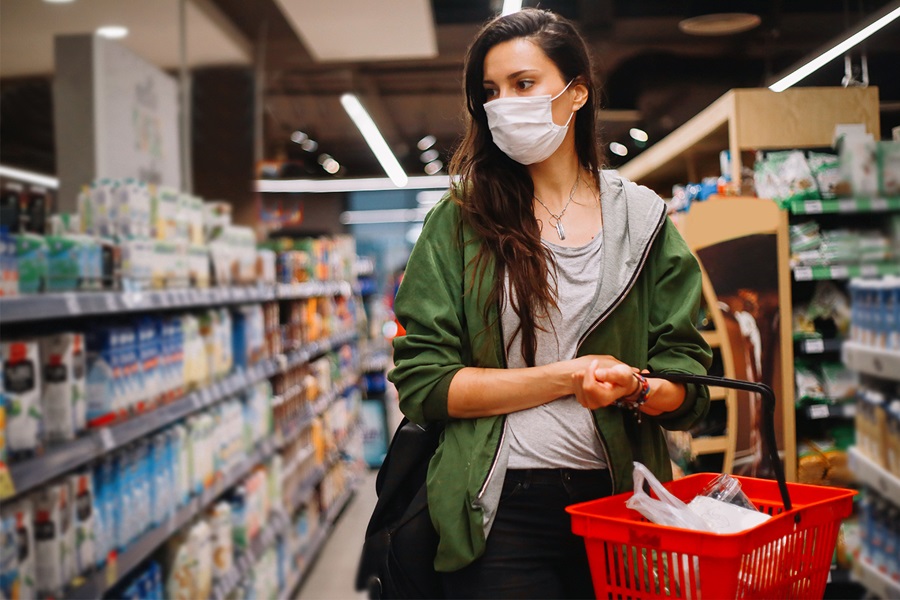As we enter 2021, in some regions it feels like being back at the beginning of the pandemic, whilst in others there are barely any restrictions. In these ten insights we have revisited some of the important trends we discussed early on: We take a look at the impact of FMCG growth across the world; the acceleration of ecommerce by region; which sectors, categories, manufacturers and brands did best; and how the pandemic has impacted real purchasing behaviour.
How COVID-19 influenced our behaviour in 2020, and how we think it will impact in 2021:
- FMCG growth is set to reach 10% by the end of Q1 2021. But it is unlikely we are ever going to see double-digit take-home FMCG growth again. A correction is inevitable. The scale and timing of this correction, though, depends on so many unknowns: vaccine rollout plans, recessionary impact, post-pandemic working from home, changes to restrictions, and so on. This scenario slowly takes the gains made from “staying at home” away, while reintroducing older trends.
- But FMCG growth in China is declining: The average global growth doesn’t show the whole picture, given Mainland China (the largest contributor) and four other countries saw slower take-home FMCG growth during the pandemic than before. The weak sales performance during the Chinese New Year is primarily responsible for the China decline. This year, however, given restrictions are now minimal, we expect a bumper return in this market.
- Ecommerce share of FMCG is set to reach 12% by the end of Q1: that’s the equivalent of two years share growth in one year. However, looking specifically at Europe, ecommerce is set to reach 9% share of FMCG sales, making it the most accelerated retail trend of the year. We see big gains in Latam too, but overall share remains under 1%. Is this another signal of the West beginning to follow the trends coming from the East? Expect some decline in share this year, particularly if a recession bites.
- The Health & Beauty sector has gone from the fastest growing (in 2019) to the slowest during the pandemic. The opposite is true for the Food sector (not including food for consumption Out-of-Home). In fact, all FMCG sectors aside from Health & Beauty benefitted from us being at home more. Beauty though, however, is more reliant on how others see us. Expect a strong recovery when we can go out again!
- Strong growth in FMCG is also seen at a category level, with two in three categories growing faster during the pandemic than before; ten are seeing double-digit growth. What is particularly interesting are how the pandemic has revived certain categories, such as Cider, Aircare and Wine. However, will these categories be the most vulnerable when “normality” returns?
- Three global manufacturers saw an increase in growth by 10% or more since the pandemic: Reckitt Benckiser (RB), Kellogg’s and Kraft Heinz. Breakfast has always been more of an in-home occasion, but cereals had been slowly losing out to alternatives. However, this hasn’t stopped Kellogg’s winning big during the pandemic. Kraft-Heinz is perhaps less surprising: we like meal solutions that are easy to store and make; condiments, like Ketchup, have also grown.
- The two fastest growing FMCG brands in the world in 2019 are proven killers of the COVID-19 virus: Dettol and Harpic, both manufactured by RB. This may be unsurprising, as our hygiene routines, of course, have dramatically changed over the last year. This is likely to reduce in the future, but will remain considerably higher than before the pandemic.
- Everywhere, people shopped less and bought more per trip. Europe again saw the most dramatic changes in shopping behaviour. However, this behaviour is unlikely to revert to previous levels. Our general shopping plans will be more flexible – less planned – again, because they can be.
- Looking at data from the UK, we see that (when including the reduction in our out-of-home food and drink spending) overall our spend has gone down, despite the strong growth for both FMCG/grocery shopping and home meal delivery. In fact, many households have been saving money in general, as travel costs (work and holiday, in particular) have been reduced. Will they spend big when allowed to do so? Unlikely, as the unemployment and economy fears will increase caution.
- The after-effects of the pandemic – how the economy recovers especially – are going to stay with us for the next few years at least. In the final slide in the downloadable deck you can see what themes we think will come back strongly, with new lower-level ones likely to get even more bandwidth as we re-open the world.
Note: The data referenced in insights 1-8 is from Kantar’s FMCG take-home purchase panels. Markets included: Argentina, Bolivia, Brazil, Central America, Chile, Chinese Mainland, Colombia, Ecuador, France, Great Britain, Ghana, Greece, Ireland, India, Indonesia, Kenya, Malaysia, Mexico, Peru, Philippines, Portugal, Saudi Arabia, South Korea, Spain, Taiwan, Thailand, Vietnam.


